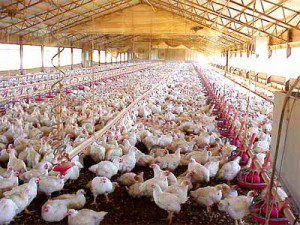

This hypothesis is based on the notion that viruses which kill their hosts too quickly are not efficiently transmitted, and are therefore removed by selection. However a vaccine that prevents disease, but not viral replication in the host, would allow virulent viruses to be maintained in the host population. It has been suggested that in this scenario, viruses with increased virulence would be selected if such a property aids transmission between hosts.
On the surface this hypothesis seems reasonable, but in my opinion it is flawed. One problem is that increased transmission might not always be associated with increased virulence. The more serious flaw lies in making anthropomorphic assessments of what we think viruses require, such as concluding that increased viral transmission is a desired trait. Our assumptions fail to recognize the main goal of evolution: survival. Evolution does not move a virus along a trajectory aimed at perfection. Change comes about by eliminating those viruses that are not well adapted for the current conditions, not by building a virus that will fare better tomorrow. All the viruses on Earth today transmit well enough, or they would not be here; yet some kill their hosts clearly much faster than others. The fact is that humans have little understanding of what drives virus evolution in large populations. Our assumptions of what constitute the selective forces are usually tainted by anthropomorphism.
This long preamble is an introduction to a series of findings which are purported to support the idea that permissive vaccines (the authors call them ‘leaky’ and ‘imperfect’ vaccines but I dislike both names because they imply defects) can lead to the selection of more virulent viruses. The subject of the paper is Marek’s disease virus (MDV), a herpesvirus that infects chickens. MDV is shed from feather follicles of infected chickens and is spread to other birds when then inhale contaminated dust. Vaccines have been used to prevent MDV infection since the early 1970s. These vaccines prevent disease, but do not block viral replication, and vaccinated, infected birds can shed wild type virus. The virulence of MDV has been increasing since the 1950s, initially from a paralytic disease, to paralysis and death. The authors wonder if the use of permissive Marek’s vaccines has lead to the selection of more virulent viruses.
To address their hypothesis, the authors inoculate vaccinated or unvaccinated chickens with a series of MDV isolates that range from low to high virulence. Unvaccinated chickens inoculated with the most virulent MDV died within a week and shed little virus. In contrast, most vaccinated birds survived infection with virulent viruses, and shed virus for the length of the experiment, 56 days.
A transmission experiment was done to determine if shed virus could infect other birds. The authors infected vaccinated or unvaccinated birds and asked if sentinel, unvaccinated chickens became infected. Unvaccinated birds died within 10 days after infection with virulent MDV, and did not transmit infection. In contrast, vaccinated birds survived at least 30 days, and co-housed sentinel animals became infected and died.
The experiments are well done and the conclusions are clear: more virulent Marek’s disease viruses replicate longer in vaccinated than unvaccinated chickens, and can be readily transmitted to other chickens. But these results do not prove that more virulent MDV arose because of permissive vaccines. Nor do the results prove in general that leaky vaccines lead to selection of more virulent viruses. The results simply show that a vaccine that does not prevent replication will allow transmission of virulent viruses.
To prove that vaccinated chickens can allow the selection of more virulent viruses, vaccinated chickens could be infected with an avirulent virus, and the shed virus collected and used to infect additional, vaccinated birds. This process could be repeated to determine if more virulent viruses arise. While the results of this gain-of-function experiment would be informative, they would be done in a controlled laboratory setting which would not duplicate all the selective forces present on a poultry farm.
The authors note that most human vaccines do prevent replication of infecting virus. They do not mention the one important exception: the Salk poliovirus vaccines. People who are immunized with the Salk vaccine can be infected with poliovirus, which will then replicate in the intestines, be shed in the feces, and transmitted to others. This behavior has been well documented in human populations, yet the virulence of poliovirus has not increased for the 60 years during which the Salk vaccine has been used.
I do not feel that these experimental results have general implications for the use of any animal vaccine. It is unfortunate that the work has been covered in many news sources with the incorrect implication that vaccines may be responsible for the emergence of more virulent viruses.

Great analysis. Totally agree that “To prove that vaccinated chickens can allow the selection of more virulent viruses, vaccinated chickens could be infected with an avirulent virus, and the shed virus collected and used to infect additional, vaccinated birds.”
These news views article frequently are making some stuff to sound more than it really is. Typical headline hunters.
posted by David Usharauli
Hi Vincent,
great post!
(Side note: I think the first sentence in the second-to-last paragraph should say “…most human vaccines DO prevent replication of infecting virus.”)
Thank you Kyril, error fixed.
I left a detailed query re the pertussis vaccine on this article, which I suggest is relevant here. Why hasn’t it been published?
Pingback: Permissive vaccines and viral virulence | Tools...